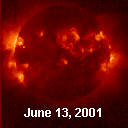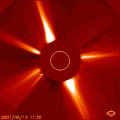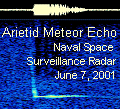|   SPACE WEATHER SPACE WEATHER
Current
Conditions
Solar Wind
velocity: 361.3 km/s
density:12.8 protons/cm3
explanation | more data
Updated: Today at 2245 UT
X-ray Solar Flares
6-hr max: C3 1705 UT Jun14
24-hr: C6 0940 UT Jun14
explanation | more data
Updated: Today at 2245 UT
Daily Sun: 14 Jun '01 
None of the many spots on the Sun's disk have magnetic fields more complex than beta-class. Nevertheless, newly-numbered active region 9502 has unleashed two M-class solar flares since Wednesday. Image credit: SOHO/MDI
The Far Side of the Sun
This holographic image reveals one mid-sized spot group on the far side of the Sun. Image credit: SOHO/MDI
Sunspot Number: 221
More about sunspots
Updated: 13 Jun 2001
Radio Meteor Rate
24 hr max: 32 per hr
Listen to the Meteor Radar!
Updated: 14 Jun 2001 Interplanetary Mag. Field
Btotal: 7.3 nT
Bz: 0.2 nT north
explanation | more data
Updated: Today at 2246 UT Coronal Holes:

There are no substantial Earth-facing coronal holes on the Sun today. Image credit: Yohkoh Soft X-ray Telescope.
More about coronal holes
 SPACE WEATHER SPACE WEATHER
NOAA
Forecasts
Solar Flares: Probabilities for a medium-sized (M-class) or a major (X-class) solar flare during the next 24/48 hours are tabulated below.
Updated at 2001 Jun 14 2200 UT
| FLARE | 24 hr | 48 hr | | CLASS M | 65 % | 65 % | | CLASS X | 10 % | 10 % |
Geomagnetic Storms: Probabilities for significant disturbances in Earth's magnetic field are given for three activity levels: active, minor storm, severe storm
Updated at 2001 Jun 14 2200 UT Mid-latitudes | 24 hr | 48 hr | | ACTIVE | 15 % | 20 % | | MINOR | 10 % | 15 % | | SEVERE | 05 % | 05 % |
High latitudes | 24 hr | 48 hr | | ACTIVE | 25 % | 30 % | | MINOR | 10 % | 15 % | | SEVERE | 05 % | 05 % |

Web server provided by
VPS Hosting
| What's Up in Space -- 14 Jun 2001
Subscribe to Space Weather News!  SOLAR ACTIVITY: On Wednesday, June 13th, sunspot group 9502 unleashed a strong M7-class solar flare. The eruption propelled a coronal mass ejection (CME) into space from the Sun's east limb (the cloud is not heading for Earth). The face of the Sun is peppered with spots, and forecasters estimate a 50% chance of additional M-class flares during the next 24 hours. Above: The ESA/NASA Solar and Heliospheric Observatory captured this coronagraph movie of Wednesday's CME billowing away from sunspot 9502. SOLAR ACTIVITY: On Wednesday, June 13th, sunspot group 9502 unleashed a strong M7-class solar flare. The eruption propelled a coronal mass ejection (CME) into space from the Sun's east limb (the cloud is not heading for Earth). The face of the Sun is peppered with spots, and forecasters estimate a 50% chance of additional M-class flares during the next 24 hours. Above: The ESA/NASA Solar and Heliospheric Observatory captured this coronagraph movie of Wednesday's CME billowing away from sunspot 9502.
THE BIGGEST EXPLOSIONS IN THE SOLAR SYSTEM: NASA's HESSI spacecraft aims to unravel an explosive mystery: the origin of solar flares. [full story]  RADIO METEORS: The annual Arietid meteor shower peaked on Thursday, June 7th. The Arietids are unusual because they are daytime meteors -- most of them streak through the sky unnoticed while the bright Sun is overhead. Nevertheless, you can listen to the elusive Arietids (the shower remains active until early July) by tuning in to NASA's online meteor radar. Radio meteor listener Stan Nelson captured this radar echo from an Arietid that passed above the Naval Space Surveillance Radar on June 7th. [FULL STORY] RADIO METEORS: The annual Arietid meteor shower peaked on Thursday, June 7th. The Arietids are unusual because they are daytime meteors -- most of them streak through the sky unnoticed while the bright Sun is overhead. Nevertheless, you can listen to the elusive Arietids (the shower remains active until early July) by tuning in to NASA's online meteor radar. Radio meteor listener Stan Nelson captured this radar echo from an Arietid that passed above the Naval Space Surveillance Radar on June 7th. [FULL STORY]
WEB LINKS: NOAA FORECAST | GLOSSARY | SPACE WEATHER TUTORIAL | LESSON PLANS | BECOME A SUBSCRIBER | 
Potentially Hazardous Asteroids (PHAs) are space rocks larger than approximately 100m that can come closer to Earth than 0.05 AU. None of the known PHAs are on a collision course with our planet, although astronomers are finding new ones all the time. [more]
On 14 Jun 2001 there were 310 known Potentially
Hazardous Asteroids May-June 2001 Earth-asteroid encounters | ASTEROID | DATE (UT) | MISS DISTANCE | | 2001 FE90 | 2001-May-06 23:37 | 49.7 LD | | 1999 KW4 | 2001-May-25 23:31 | 12.6 LD | | 2001 JV1 | 2001-Jun-06 07:53 | 18.0 LD | Note: LD is a "Lunar Distance." 1 LD = 384,401 km, the distance between Earth and the Moon. 1 LD also equals 0.00256 AU. 
- TOTAL LUNAR ECLIPSE: On Jan. 9, 2001, the full Moon glided through Earth's copper-colored shadow. [gallery]
- CHRISTMAS ECLIPSE: Sky watchers across North America enjoyed a partial solar eclipse on Christmas Day 2000 [gallery]
- LEONIDS 2000: Observers around the globe enjoyed three predicted episodes of shooting stars. [gallery]
 Feb. 21, 2001: Nature's Tiniest Space Junk -- Using an experimental radar at the Marshall Space Flight Center, scientists are monitoring tiny but hazardous meteoroids that swarm around our planet. Feb. 15, 2001: The Sun Does a Flip -- NASA scientists who monitor the Sun say our star's enormous magnetic field is reversing -- a sure sign that solar maximum is here. Jan. 25, 2001: Earth's Invisible Magnetic Tail -- NASA's IMAGE spacecraft, the first to enjoy a global view of the magnetosphere, spotted a curious plasma tail pointing from Earth toward the Sun. Jan. 4, 2001: Earth at Perihelion -- On January 4, 2001, our planet made its annual closest approach to the Sun. Dec. 29, 2000: Millennium Meteors -- North Americans will have a front-row seat for a brief but powerful meteor shower on January 3, 2001. Dec. 28, 2000: Galileo Looks for Auroras on Ganymede -- NASA's durable Galileo spacecraft flew above the solar system's largest moon this morning in search of extraterrestrial "Northern Lights" Dec. 22, 2000: Watching the Angry Sun -- Solar physicists are enjoying their best-ever look at a Solar Maximum thanks to NOAA and NASA satellites. MORE SPACE WEATHER HEADLINES |

